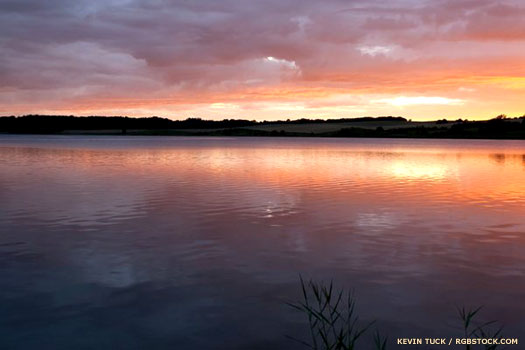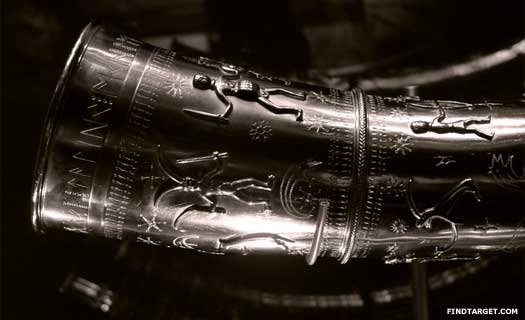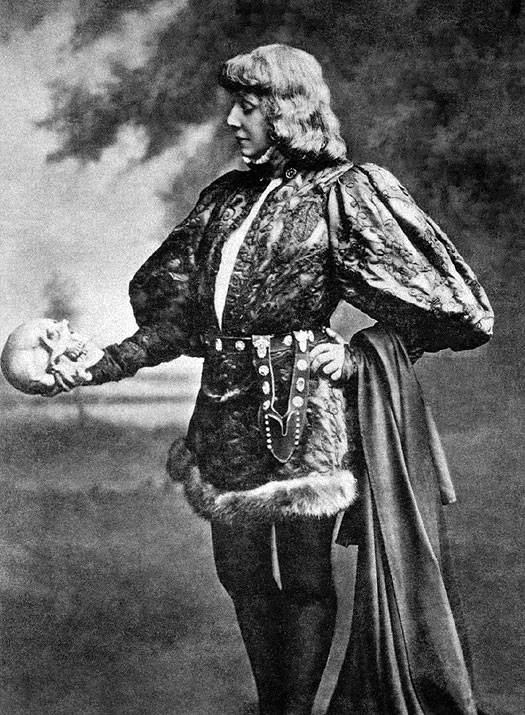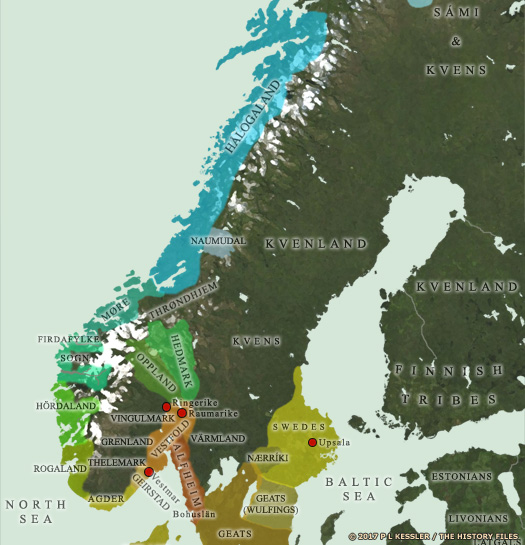 |
|
|
| (Information by Peter Kessler, with additional information from Gesta Danorum, Saxo Grammaticus, from Chronicon Lethrense, (anonymous), from Hrólfs saga kraka, from the Alan Bliss/JRR Tolkein examination of the fragment known as The Fragment and the Episode, from The Oxford History of England: The English Settlements, J N L Meyers, from Ulwencreutz's The Royal Families in Europe V, Lars Ulwencreutz, and from External Links: An Anglo-Saxon Dictionary (Bosworth and Toller, 1898), and Geography, Strabo (H C Hamilton & W Falconer, London, 1903, Perseus Online Edition), and Geneanet.) |
|
|
| fl c.500 |
Getwulf |
Probable first Danish prince or king of Jutland. |
It seems a remarkable coincidence that the first prince or king of Danish Jutland should bear almost exactly the same name as the last ruler of the Jutes before him, and in exactly the same region. Are the figures one and the same (unlikely given the presumed time span), or is there a familial connection, either through Jutish blood alone (since lost to history), or via a Danish intermarriage? Another alternative is that the name has been appended to this list simply as a way of claiming continuity or territorial inheritance.  Jutland was governed as a principality during the early Danish period in the Cimbric peninsula, but may have begun life as an independent Danish kingdom Jutland was governed as a principality during the early Danish period in the Cimbric peninsula, but may have begun life as an independent Danish kingdom |
|
|
| fl c.520s |
Wulfgar |
At the court of Hrothgar of the Danes. |
| Finn |
Possibly named after the famous [Frisian](FranceHolland.htm#Offo Kings) king. |
|
| 540s |
By now the Heruli appear to have moved to the far north of the Cimbric peninsula, into Jutland, apparently expelled by the Danes further south. Their new settlement could be in the Maelar Valley on the northern trade route. Their subsequent entry into Sweden is poorly documented. |
|
| Rorik / Röricus or Gervendill |
Rurik Slyngebard of the Danes? |
|
| 580s |
It seems a coincidence that there is a Rorik here at the same time as Rurik Slyngebard sits on the Danish throne. This does make it somewhat likely that they are one and the same person. However he gets his information, Saxo Grammaticus places one 'Gervendill' in Jutland as prince or governor during Rorik's reign. This name seems likely to be the same as that of 'Horvendil', Rorik's son and successor.  Shown here is a replica of one of the fifth century 'Golden Horns of Gallehus' which were discovered in Denmark Shown here is a replica of one of the fifth century 'Golden Horns of Gallehus' which were discovered in Denmark |
|
| Orvendil / Horvendil / Orwendel |
Son. Saxo Grammaticus' 'Gervendill'? Murdered by Fengi. |
|
| According to Saxo Grammaticus, Horvendil returns from a Viking expedition in which he has killed Koll, (a) king of Norway and marries Gerutha, daughter of King Rurik Slyngebard of the Danes. His brother, Fengi, murders him through jealousy and persuades Gerutha to marry him. Although the story is close to the later version by Shakespeare, it ends with the death of Amleth in battle against Fengi's successor, Wiglek. These events may or may not happen at this time as there is the possibility that they instead survive in oral form from the beginning of the fifth century, when the Angles and Jutes inhabit the region. |
|
|
| Fengi / Feng |
Brother. Murdered his brother. Killed by Amleth. |
|
| Amleth Orvendilson / Amblothe |
Son of Orvendil. Shakespeare's 'Hamlet'. |
|
| fl c.610s? |
Wiglek |
Saxo Grammaticus' successor to Fengi. |
Wiglek is claimed by the Danish Chronicon Lethrense as the son of Rurik Slyngebard of the Danes. This may be true, but the name is also confused (and combined) with that of Wihtlaeg, king of Angeln and son of Woden.  The semi-legendary Amleth Orvendilson of Scandinavian tradition is the direct inspiration for Shakespeare's Hamlet, although the story underwent some filtering by later historians (the great French actress of the late nineteenth century, Sarah Bernhardt, played Hamlet between 1880-1885) The semi-legendary Amleth Orvendilson of Scandinavian tradition is the direct inspiration for Shakespeare's Hamlet, although the story underwent some filtering by later historians (the great French actress of the late nineteenth century, Sarah Bernhardt, played Hamlet between 1880-1885) |
|
|
| As there is an approximate gap of two centuries between the two figures it would seem that an error is made between the oral tradition and the later written version of the names which are involved. Alternatively, the earlier Wihtlaeg is a mis-remembering of this possibly historic Wiglek and has been drawn into Anglian genealogies because of his later fame. |
|
|
| 700s? |
A series of rulers are ascribed to Jutland for this period, between the late eighth century to the mid-ninth, and seemingly following a gap in the known rulers of the region. It is unclear who they are and from where they originate until the title 'King of Vestfold-Jutland' appears in genealogies. The Vestfold kingdom is Norse, lying almost directly north of Jutland across the Skagerrak strait which is fed from the North Sea. Also at this time the Danish kingdom is somewhat weak and fractured, not even having fully unified yet. It would seem likely that Vestfold has expanded its reach into territory which the Danes - to date - have never really controlled.  This map shows a host of the many petty Norwegian kingdoms in eighth and ninth century Scandinavia, most of them arranged along the coastline, although penetration into the interior is clearly beginning (click or tap on map to view full sized) This map shows a host of the many petty Norwegian kingdoms in eighth and ninth century Scandinavia, most of them arranged along the coastline, although penetration into the interior is clearly beginning (click or tap on map to view full sized) |
|
| Olaf I |
Same as king of Vestfold? Uncertain. |
|
| Ragnvald Olafsson |
Son. |
|
| fl c.800 |
Gudrod Halfdansson 'Jagtkonge' |
Son of Halfdan II hinn Mildi. 'King of Vestfold-Jutland'. |
| Gudrod Halfdansson 'Jagtkonge' would appear to be the same person as Gudrod 'the Magnificent', king of Raumarike and Vestfold (with Bohuslän and Vingulmark). His son and successor in Vestfold is Olaf Gudrodsson Geirstad-Alf, who would appear to match up with the Olaf II shown below. |
|
|
| c.800 - 840 |
Olaf II Guddrodson |
Son. 'King of Vestfold-Jutland' (until 827?). |
| fl mid-800s |
Eirik / Eric |
Possibly the same as Eric, king of Denmark. |
| mid-800s |
Eirik may be the same person as King Eric (I or II) of Denmark. This would explain why the principality appears to be drawn under the direct control of the Danish throne at this time. However, this Eirik is also claimed by Norse sagas as the father of Ragnhidr (Ragnhild), the wife of King Harald I Fairhair of Norway, whose son by her is Eric Bloodaxe.  |
|
| Either way, control of Jutland by Vestfold does not seem to continue. Instead, the Danish throne - now stronger and more unified - appears to take firmer control of the region to draw it within central governance. |
|
|
 |
|
|
 The birth of the modern Danish nation took place following the Viking age, along with the simultaneous arrival of Christianity in Scandinavia and Fennoscandia (see feature link for an examination of the origins of 'Scandinavia' as a name). Before that, the Scandinavians were contained entirely within the southernmost third of Sweden and Norway. Initial settlement and the spread of early kingdoms largely followed the rivers, with inland areas being only sparsely inhabited. The rest was part of a poorly-defined (and poorly understood) territory known as Kvenland, which stretched all the way east into modern Russia. The Danes originally emerged in southernmost Sweden, part of a Scandinavian tribal collective which suffered divisions in the fourth and fifth centuries AD. As a result, they began to migrate outwards, gradually entering Jutland and the Cimbric peninsula in the fifth century. This was a relatively peaceful movement (although battles seem to have been fought) which nevertheless placed pressure on the Jutes and Angles who were already there, and contributed to their migration to Britain. The Angles appear to have been allies of the Danes, but may have seen the migration as an opportunity which was not to be missed. The Jutes, formerly powerful in their own right, were weakened by the Danes, hastening their departure. Jutland probably did not remain deserted for long. Within half a century Danish groups were helping to create what seems to have become a minor kingdom or sub-kingdom in its own right. Jutland, the northernmost point of the Cimbric peninsula, was soon governed by a prince of the Danish royal house. Despite (or perhaps because of) this link, Jutland was sometimes hostile to the Danish throne. The position was inherited by the descendants of the first prince until the mid-ninth century, when it was apparently drawn directly under the control of the Danish king. Shakespeare's 'Hamlet' was drawn from the princes of Jutland, based on the work of Saxo Grammaticus: Gesta Danorum. Grammaticus completed his work at the start of the thirteenth century, although his sources are unknown. It seems to be a little late for it to be a purely oral tradition, so at least some of it had probably already been written down. The earlier Chronicon Lethrense probably served as a strong source of the work, as did a Scandinavian version known as Hrólfs saga kraka. It is also possible that the story reached English ears via Ireland, following the Viking invasions and the creation of the kingdom of Dublin.
The birth of the modern Danish nation took place following the Viking age, along with the simultaneous arrival of Christianity in Scandinavia and Fennoscandia (see feature link for an examination of the origins of 'Scandinavia' as a name). Before that, the Scandinavians were contained entirely within the southernmost third of Sweden and Norway. Initial settlement and the spread of early kingdoms largely followed the rivers, with inland areas being only sparsely inhabited. The rest was part of a poorly-defined (and poorly understood) territory known as Kvenland, which stretched all the way east into modern Russia. The Danes originally emerged in southernmost Sweden, part of a Scandinavian tribal collective which suffered divisions in the fourth and fifth centuries AD. As a result, they began to migrate outwards, gradually entering Jutland and the Cimbric peninsula in the fifth century. This was a relatively peaceful movement (although battles seem to have been fought) which nevertheless placed pressure on the Jutes and Angles who were already there, and contributed to their migration to Britain. The Angles appear to have been allies of the Danes, but may have seen the migration as an opportunity which was not to be missed. The Jutes, formerly powerful in their own right, were weakened by the Danes, hastening their departure. Jutland probably did not remain deserted for long. Within half a century Danish groups were helping to create what seems to have become a minor kingdom or sub-kingdom in its own right. Jutland, the northernmost point of the Cimbric peninsula, was soon governed by a prince of the Danish royal house. Despite (or perhaps because of) this link, Jutland was sometimes hostile to the Danish throne. The position was inherited by the descendants of the first prince until the mid-ninth century, when it was apparently drawn directly under the control of the Danish king. Shakespeare's 'Hamlet' was drawn from the princes of Jutland, based on the work of Saxo Grammaticus: Gesta Danorum. Grammaticus completed his work at the start of the thirteenth century, although his sources are unknown. It seems to be a little late for it to be a purely oral tradition, so at least some of it had probably already been written down. The earlier Chronicon Lethrense probably served as a strong source of the work, as did a Scandinavian version known as Hrólfs saga kraka. It is also possible that the story reached English ears via Ireland, following the Viking invasions and the creation of the kingdom of Dublin.
 Jutland was governed as a principality during the early Danish period in the Cimbric peninsula, but may have begun life as an independent Danish kingdom
Jutland was governed as a principality during the early Danish period in the Cimbric peninsula, but may have begun life as an independent Danish kingdom Shown here is a replica of one of the fifth century 'Golden Horns of Gallehus' which were discovered in Denmark
Shown here is a replica of one of the fifth century 'Golden Horns of Gallehus' which were discovered in Denmark The semi-legendary Amleth Orvendilson of Scandinavian tradition is the direct inspiration for Shakespeare's Hamlet, although the story underwent some filtering by later historians (the great French actress of the late nineteenth century, Sarah Bernhardt, played Hamlet between 1880-1885)
The semi-legendary Amleth Orvendilson of Scandinavian tradition is the direct inspiration for Shakespeare's Hamlet, although the story underwent some filtering by later historians (the great French actress of the late nineteenth century, Sarah Bernhardt, played Hamlet between 1880-1885) This map shows a host of the many petty Norwegian kingdoms in eighth and ninth century Scandinavia, most of them arranged along the coastline, although penetration into the interior is clearly beginning (click or tap on map to view full sized)
This map shows a host of the many petty Norwegian kingdoms in eighth and ninth century Scandinavia, most of them arranged along the coastline, although penetration into the interior is clearly beginning (click or tap on map to view full sized)
